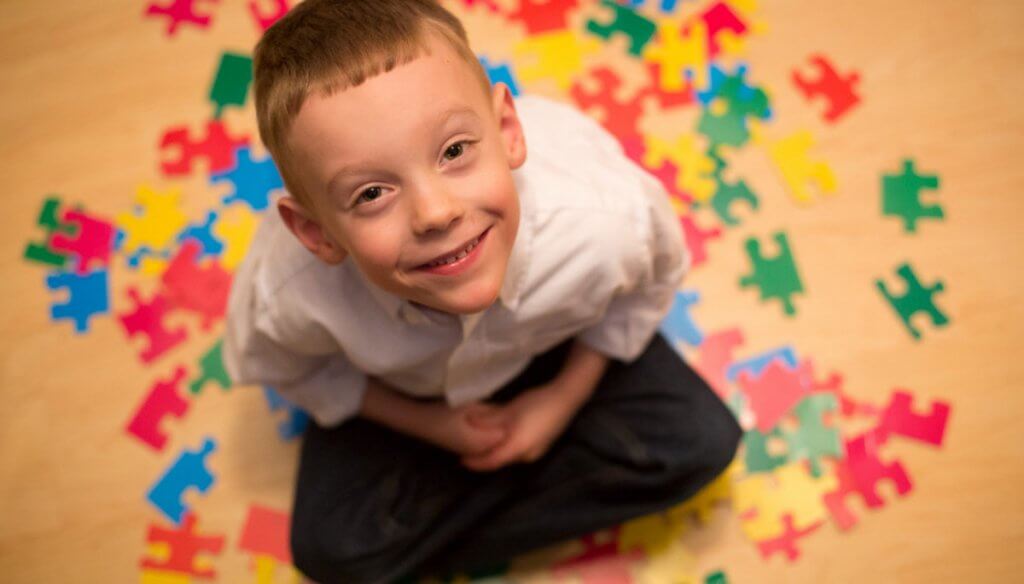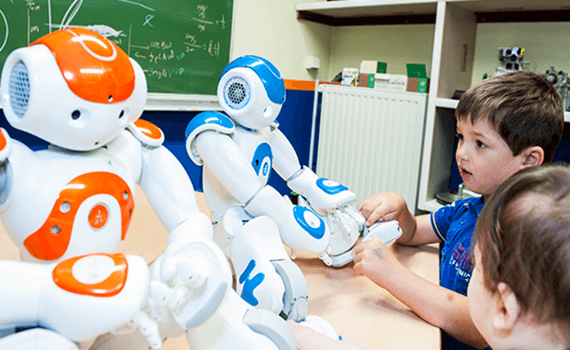Autism Is Nothing to Be Ashamed of, But Ignorance Is

Autism is classified as a developmental disorder that affects communication and social relationships. A child with autism has a more limited repertoire of interests and activities, with a tendency towards repetition and stereotypy.
Given the great variability of symptoms, both the American Psychiatric Association and the Diagnostic and Statistical Manual of Mental Disorders (DSM) have extended the classification to a broader denomination: autism spectrum disorders.
Think of a 3-year-old child who does not play with others and also has a limited behavioral repertoire. A 10-year-old girl who speaks in a monotone, doesn’t know how to express her emotions but is very good at math or has an extraordinary memory. Taking into account individual differences, we ask ourselves: what is autism and what does it imply? How should we intervene?
Changes in the definition of autism and differential diagnosis
In the DSM-IV, the category of Pervasive Developmental Disorders involves five subtypes of autism:
- autistic disorder
- Asperger’s syndrome
- childhood disintegrative disorder
- pervasive developmental disorder not otherwise specified (PDD-NOS)
- Rett syndrome
On the other hand, in the DSM-V, four of these subtypes (autistic disorder, Asperger’s syndrome, childhood disintegrative disorder, and PDD-NOS) have been replaced by the general category “autistic spectrum disorders” (ASD).
Rett syndrome is no longer part of this classification system. Instead of distinguishing between these subtypes, the diagnostic definition of the DSM-V specifies three levels of severity in the symptoms, as well as the level of support needed.

Research into autism
There have been many advances in autism research since 2000. We have been able to distinguish between variants of certain genetic chains that are involved in the genesis of autism, so there is clearly a neurodevelopmental component. Many of these genes are involved in communication between neurons, which lead to some of the functional abnormalities that we recognize in autism.
Although this research has helped us understand some of the causes of autism, we must make clear that autism is not determined by a “genetic failure.” Genetic components do, in some way, predispose a person to autism, yes. But that is not enough for a person to develop autism. The multicausality makes possible the variety of symptoms that we find in people with autism.
To keep in mind
- In educational clinical practice, it is evident that autistic children reject contact with others from a very early age, as early as 12 months. They do not benefit from auditory and tactile sensory cues, so important for socio-affective development.
- This lack of attachment to stimulation, especially with communication and interaction, causes the child to increase self-stimulation. It also makes it harder for parents and teachers to guide them. This then causes developmental delays.
- The explanation of why some are born with this rejection of the social and prefer self-stimulated behavior resides in neurology, but the key has not been found.
- Research from different perspectives, from Kanner to Lovaas and Bijou et al., help us infer neurological differences in autistic children. The “autistic manifestations” of a child with Rett syndrome are not the same as a child with Asperger’s syndrome.
- We must clearly differentiate an autism diagnosis from other disorders based on lack of social interest. These include auditory deficits, nervous habits or tics, or an absence of minimum levels of early stimulation.
Evaluating and intervening in autism
As professionals, when we are about to make an evaluation, we have to handle ethical issues very well. We must address the impact on parents and make realistic predictions. We should communicate that the disorder varies in its manifestation and avoid stigmatization.
How do professionals evaluate autism?
- Physical exams, sensory system and response system tests, neurological screenings.
- Talking to the parents. In an unstructured way, ask for information about the pregnancy, the child’s health, and the parent-child relationship.
- Measure deficits, especially in relation to social and personal autonomy and behavioral excesses. These include self-stimulated behaviors.
- IQ tests do not have a place in cases of moderate autism because their results can be confusing.

Intervention
The fundamental areas of intervention are:
The child’s low sensitivity to social aspects
We have to increase social interaction.
- Human touch can prevent self-stimulated behaviors. This does not mean, however, that we have to treat them like babies.
- Talk to the child a lot. Treat them as people with the ability to speak; do not form prejudices. If we talk a lot, imitation will be more natural and spontaneous.
- Find out what they like. Their stereotypies can give us a clue here. Know what interests them so you can to introduce a social task in which they will need to collaborate with other children.
- If they have a special ability, incorporate it into a group activity. This will increase their self-esteem. For example, if they typically are very good at puzzles or building games, make that part of the activity.
- Animal therapy has had good results, such as therapy with horses, dolphins, or dogs.

The child’s high levels of self-stimulation
Their self-stimulated behaviors need to be limited. On the other hand, they need to be connected to the social world and their environment.
- Involve all those who may be encouraging or permitting disruptive behaviors. We have to be careful in this respect because children may maintain these behaviors as a way to get attention or stimulation lacking from others.
- Change biological states, such as meals, rest patterns, and schedules so the child’s demands have less aversive connotations and are more functional. Reinforce behaviors that are incompatible with self-stimulation.
- Never lose your calm and NEVER use any kind of force or physical punishment. It is never warranted, whether to dissuade them or to stop a disruptive behavior.
In conclusion, we must be clear that any type of intervention requires thorough programming where desired behaviors are reinforced. Furthermore, the instructions we give them must be clear and we must be systematic and patient.
Autism is classified as a developmental disorder that affects communication and social relationships. A child with autism has a more limited repertoire of interests and activities, with a tendency towards repetition and stereotypy.
Given the great variability of symptoms, both the American Psychiatric Association and the Diagnostic and Statistical Manual of Mental Disorders (DSM) have extended the classification to a broader denomination: autism spectrum disorders.
Think of a 3-year-old child who does not play with others and also has a limited behavioral repertoire. A 10-year-old girl who speaks in a monotone, doesn’t know how to express her emotions but is very good at math or has an extraordinary memory. Taking into account individual differences, we ask ourselves: what is autism and what does it imply? How should we intervene?
Changes in the definition of autism and differential diagnosis
In the DSM-IV, the category of Pervasive Developmental Disorders involves five subtypes of autism:
- autistic disorder
- Asperger’s syndrome
- childhood disintegrative disorder
- pervasive developmental disorder not otherwise specified (PDD-NOS)
- Rett syndrome
On the other hand, in the DSM-V, four of these subtypes (autistic disorder, Asperger’s syndrome, childhood disintegrative disorder, and PDD-NOS) have been replaced by the general category “autistic spectrum disorders” (ASD).
Rett syndrome is no longer part of this classification system. Instead of distinguishing between these subtypes, the diagnostic definition of the DSM-V specifies three levels of severity in the symptoms, as well as the level of support needed.

Research into autism
There have been many advances in autism research since 2000. We have been able to distinguish between variants of certain genetic chains that are involved in the genesis of autism, so there is clearly a neurodevelopmental component. Many of these genes are involved in communication between neurons, which lead to some of the functional abnormalities that we recognize in autism.
Although this research has helped us understand some of the causes of autism, we must make clear that autism is not determined by a “genetic failure.” Genetic components do, in some way, predispose a person to autism, yes. But that is not enough for a person to develop autism. The multicausality makes possible the variety of symptoms that we find in people with autism.
To keep in mind
- In educational clinical practice, it is evident that autistic children reject contact with others from a very early age, as early as 12 months. They do not benefit from auditory and tactile sensory cues, so important for socio-affective development.
- This lack of attachment to stimulation, especially with communication and interaction, causes the child to increase self-stimulation. It also makes it harder for parents and teachers to guide them. This then causes developmental delays.
- The explanation of why some are born with this rejection of the social and prefer self-stimulated behavior resides in neurology, but the key has not been found.
- Research from different perspectives, from Kanner to Lovaas and Bijou et al., help us infer neurological differences in autistic children. The “autistic manifestations” of a child with Rett syndrome are not the same as a child with Asperger’s syndrome.
- We must clearly differentiate an autism diagnosis from other disorders based on lack of social interest. These include auditory deficits, nervous habits or tics, or an absence of minimum levels of early stimulation.
Evaluating and intervening in autism
As professionals, when we are about to make an evaluation, we have to handle ethical issues very well. We must address the impact on parents and make realistic predictions. We should communicate that the disorder varies in its manifestation and avoid stigmatization.
How do professionals evaluate autism?
- Physical exams, sensory system and response system tests, neurological screenings.
- Talking to the parents. In an unstructured way, ask for information about the pregnancy, the child’s health, and the parent-child relationship.
- Measure deficits, especially in relation to social and personal autonomy and behavioral excesses. These include self-stimulated behaviors.
- IQ tests do not have a place in cases of moderate autism because their results can be confusing.

Intervention
The fundamental areas of intervention are:
The child’s low sensitivity to social aspects
We have to increase social interaction.
- Human touch can prevent self-stimulated behaviors. This does not mean, however, that we have to treat them like babies.
- Talk to the child a lot. Treat them as people with the ability to speak; do not form prejudices. If we talk a lot, imitation will be more natural and spontaneous.
- Find out what they like. Their stereotypies can give us a clue here. Know what interests them so you can to introduce a social task in which they will need to collaborate with other children.
- If they have a special ability, incorporate it into a group activity. This will increase their self-esteem. For example, if they typically are very good at puzzles or building games, make that part of the activity.
- Animal therapy has had good results, such as therapy with horses, dolphins, or dogs.

The child’s high levels of self-stimulation
Their self-stimulated behaviors need to be limited. On the other hand, they need to be connected to the social world and their environment.
- Involve all those who may be encouraging or permitting disruptive behaviors. We have to be careful in this respect because children may maintain these behaviors as a way to get attention or stimulation lacking from others.
- Change biological states, such as meals, rest patterns, and schedules so the child’s demands have less aversive connotations and are more functional. Reinforce behaviors that are incompatible with self-stimulation.
- Never lose your calm and NEVER use any kind of force or physical punishment. It is never warranted, whether to dissuade them or to stop a disruptive behavior.
In conclusion, we must be clear that any type of intervention requires thorough programming where desired behaviors are reinforced. Furthermore, the instructions we give them must be clear and we must be systematic and patient.
This text is provided for informational purposes only and does not replace consultation with a professional. If in doubt, consult your specialist.







